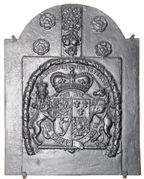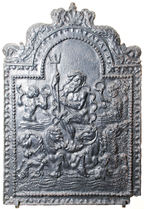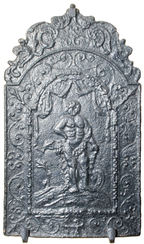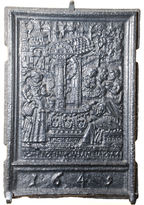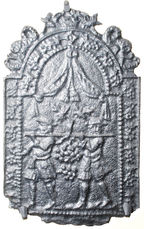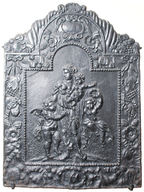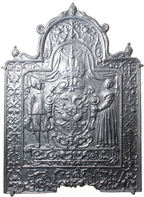-
533
Description: Arched rectangular shape; fluted pilasters supporting a lintel with nine evenly spaced flowers arranged horizontally; central standing female figure, holding a basket of flowers, a child upon her back, another child by her side, and a sheep to her left; on top, a symmetrical arrangement of an anchor, two paddles and two cornucopiae.
Notes: The figure would seem to represent Charity. One of a series with a distinctly Empire style. Mitford collection, Petworth House.
- Decoration tags:
- rectangular with round arch (shape)
- none (edging)
- whole carved pattern
- pictorial
- allegorical
- animals
- humans
Manufactured: in the late-18th to early-19th century in France.
Current location: Petworth House, Petworth, West Sussex, England.
Museum number: NT/PET/M/86 (part of the National Trust museum group)
Citation: Carpentier, H., 1912, Plaques de Cheminées (Paris, published by the author).
- Attached to series:
- Miscellaneous pattern firebacks
-
534
Description: Arched rectangular central panel with bead-on-fillet edging; pictorial scene of a seated couple (female to the left, male to the right) holding hands; behind, to the right, a sheep by a tree; arched rectangular border with fillet edging and probable foliate decoration; on top, scallop shell between two dolphins.
Notes: The symbolism of this scene is uncertain, but likely to be of an allegorical or iconological nature. Mitford collection, Petworth House.
Manufactured: in the mid- to late-17th century possibly in the Siegerland area of Germany.
Current location: Petworth House, Petworth, West Sussex, England.
Museum number: NT/PET/M/87 (part of the National Trust museum group)
- Attached to series:
- 'Dutch' Miscellaneous Firebacks
-
535
Description: Arched rectangular shape; no edging; raised central square surmounted by Royal Arms of Great Britain and Ireland, with Garter, crown and lion and unicorn supporters; surrounded by a horseshoe-shaped, twisted floral wreath, within which the inscription is printed in capitals. Above the arms a raised rectangular fillet is surmounted by two suspended floral swags, one above the other, comprising roses and oak apples. On each side of the fillet are two Tudor roses, one above the other.
Notes: Dated to between 1714 and 1801. The inscription is the visible part of an abbreviated version of the formal title of the monarch, ‘By the Grace of God, of Great Britain, France and Ireland, King, Defender of the Faith, Duke of Brunswick and Lünenburg, Arch Treasurer and Prince Elector of the Holy Roman Empire’. Mitford collection, Petworth House.
Copies of this fireback are known.
Inscription: MAG BRIT FRA ET HIB REX F D BRUN ET LUN DUX / HONY SOIT QUI MAL Y PENSE
Arms: English Hanoverian royal
- Decoration tags:
- rectangular with round arch (shape)
- none (edging)
- whole carved pattern
- armorial
- royal
- text
- plants
Manufactured: in the 18th century in England.
Current location: Petworth House, Petworth, West Sussex, England.
Museum number: NT/PET/M/89 (part of the National Trust museum group)
- Attached to series:
- Hanoverian royal armorial firebacks
-
536
Description: Arched rectangular shaped central panel with fillet and bead edging, Neptune/Poseidon, holding a trident in his right hand, sitting in a scallop shell drawn by four mythical sea horses, behind are two mermaids blowing horns; arched rectangular shaped border with ovolo egg and dart edging; above, two symmetrical dolphins with a clam shell between.
Notes: Typical type of fireback produced in Germany by Dutch pattern makers; the central panel was made separately for insertion into different borders; this border is a relatively simple type. Mitford collection, Petworth House.
Copies of this fireback are known.
- Decoration tags:
- 'Dutch' (shape)
- ovolo, egg and dart (edging)
- whole carved pattern
- pictorial
- biblical
- animals
- humans
Manufactured: in the mid- to late-17th century in the Siegerland area of Germany.
Current location: Petworth House, Petworth, West Sussex, England.
Museum number: NT/PET/M/90 (part of the National Trust museum group)
- Attached to series:
- 'Dutch' Miscellaneous Firebacks
- 'Dutch' Dolphin series
-
537
Description: Arched rectangular central panel with bead-and-pellet edging on a broad fillet; nude figure of a man standing on a mound, resting his left hand on a club, a plant to his right, and drapery swags above; arched rectangular border with symmetrical swirls; monogram centre bottom; on top, symmetrical, swirled foliage.
Notes: The figure is probably of Hercules. The depiction may have been adapted from the image of the divine hero in 'Speculum Romanae Magnificentiae', a collection of engravings dated 1573 by Antonio Lafreri after Philippe Thomassin. Mitford collection, Petworth House.
Copies of this fireback are known.
Inscription: SHR
- Decoration tags:
- 'Dutch' (shape)
- fillet (edging)
- whole carved pattern
- pictorial
- mythological
- monogram
- text
- humans
Manufactured: in the late-17th to early-18th century in England.
Current location: Petworth House, Petworth, West Sussex, England.
Museum number: NT/PET/M/91 (part of the National Trust museum group)
- Attached to series:
- SHR series
- British 'Dutch' style firebacks
-
550
Description: Rectangular; flanged edging; rectangular upper panel with cyma recta edging; pictorial scene of Jesus sitting at the well with the woman of Samaria, inscription along the bottom edge; lower inset rectangular panel with date in relief.
Notes: The inscription reads: From the maiden of Samaria - John 4. Mitford collection, Petworth House.
Inscription: VOM FROWLEIN VON SAMARIA JOH 4 / 1649
- Decoration tags:
- rectangular (shape)
- flanged (edging)
- whole carved pattern
- pictorial
- biblical
- text
Manufactured: in 1649 possibly in the Eifel area of Germany.
Current location: Petworth House, Petworth, West Sussex, England.
Museum number: NT/PET/M/92 (part of the National Trust museum group)
- Attached to series:
- Stoveplates
- Woman of Samaria stoveplates
-
539
Description: Arched rectangular central panel with bead-on-fillet edging; pictorial scene of two men in mid-17t century dress carrying a large bunch of grapes on a pole between them, above them drapery; arched rectangular border with fillet edging; cascade of flowers around arch and down sides; on top, central crown with descending serpents, an urn on each shoulder of the plate.
Notes: The scene depicts Joshua and Caleb returning from Canaan with a bunch of grapes (Numbers 13: 23-4). Mitford collection, Petworth House.
Manufactured: in the late-17th century possibly in the Siegerland area of Germany.
Current location: Petworth House, Petworth, West Sussex, England.
Museum number: NT/PET/M/94 (part of the National Trust museum group)
-
540
Description: Arched rectangular central panel with bead edging; pictorial scene of Venus sitting in a couch, with two other females, swathed in drapery, a putto holding an oval mirror to her left; Arched rectangular border with fillet edging; central cartouche at top, with festoons of fruit, flowers and leaves suspended on each side from ribbons supported by rings; at the bottom, swirled ribbon around an oval compartment bearing the inscription; on top, a central cartouche from which descend a cornucopia on each side of the arch.
Notes: The design is a copy of 'The Toilet of Venus' by Simon Vouet (c.1640); the image has been reversed. The inscription indicates the style of border; other firebacks with the same inscription have the same border; similar inscriptions (e.g. L7C and L8G) indicate different borders. Von den Driesch (p.517) illustrates the same central image within an L8G border. Mitford collection, Petworth House.
Copies of this fireback are known.
Inscription: L6C
- Decoration tags:
- 'Dutch' (shape)
- fillet (edging)
- whole carved pattern
- pictorial
- mythological
- text
- humans
Manufactured: in the mid- to late-17th century in the Siegerland area of Germany.
Current location: Petworth House, Petworth, West Sussex, England.
Museum number: NT/PET/M/95 (part of the National Trust museum group)
- Attached to series:
- 'Dutch' LC/G series
-
541
Description: Arched rectangular central panel with bead edging; pictorial scene of a female holding a small child, with two putti, one on each next side of her; arched rectangular border with fillet edging; central cartouche at top, with festoons of fruit, flowers and leaves suspended on each side from ribbons supported by rings; at the bottom, swirled ribbon around an oval compartment bearing the inscription; on top, a central cartouche from which descend a cornucopia on each side of the arch.
Notes: The allegorical figure of Charity; the inscription indicates the style of border; other firebacks with the same inscription have the same border; similar inscriptions (e.g. L7C and L8G) indicate different borders. Mitford collection, Petworth House.
Copies of this fireback are known.
Inscription: L6C
- Decoration tags:
- 'Dutch' (shape)
- fillet (edging)
- whole carved pattern
- pictorial
- allegorical
- text
- humans
Manufactured: in the mid- to late-17th century in the Siegerland area of Germany.
Current location: Petworth House, Petworth, West Sussex, England.
Museum number: NT/PET/M/96 (part of the National Trust museum group)
- Attached to series:
- 'Dutch' LC/G series
-
542
Description: Arched rectangular central panel with canted top corners and bead-on-fillet edging; elaborate central cartouche containing the double-headed eagle of the Holy Roman Emperor supported by male and female figures standing on a compartment with fillet edging, containing scrolled foliage and a central fleur-d-lys; above the central cartouche, the imperial crown and swagged drapery; arched rectangular border with canted top corners and cavetto-moulded edging; symmetrical arrangement of traceried foliage; on top, central oval casket with a serpent descending on each side of the arch to a further similar casket on each shoulder of the plate.
Notes: A variation of the standard 'Dutch' style of fireback. Mitford collection, Petworth House.
Manufactured: in the mid- to late-17th century possibly in the Siegerland area of Germany.
Current location: Petworth House, Petworth, West Sussex, England.
Museum number: NT/PET/M/97 (part of the National Trust museum group)
- Attached to series:
- 'Dutch' Miscellaneous Firebacks
- Foreign armorial firebacks


